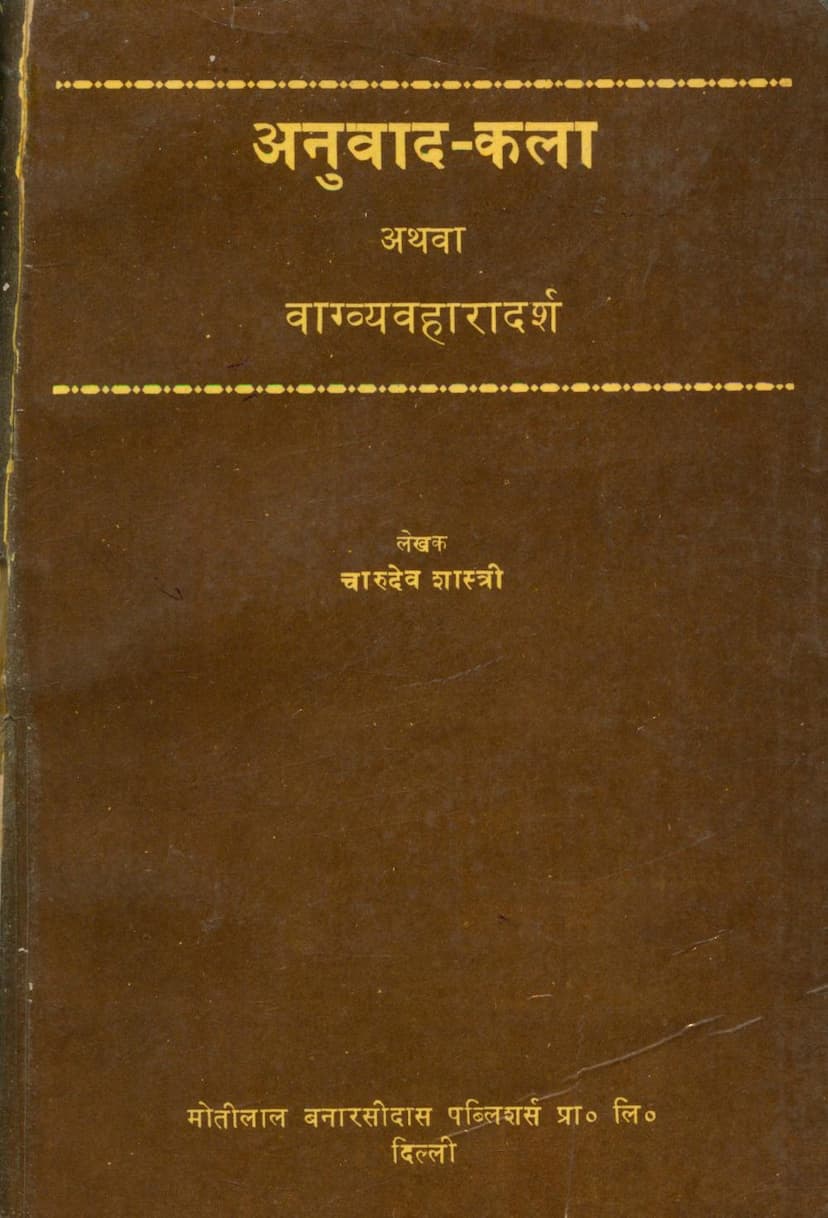Anuvad Kala
Added to library: September 1, 2025

Summary
Here's a comprehensive summary of the Jain text "Anuvad Kala" (The Art of Translation) by Charudev Shastri, based on the provided information:
Book Title: Anuvad Kala (अनुवाद-कला) or Vagvyavaharadarsh (वाग्व्यवहारादर्श) - The Art of Translation or A Mirror to Sanskrit Usage
Author: Charudev Shastri (चारुदेव शास्त्री)
Publisher: Motilal Banarsidass Pvt Ltd, Delhi
Overview:
"Anuvad Kala" is a well-known and highly regarded book on the art of Sanskrit translation, aiming to instruct students in the correct idiom and usage of Sanskrit. The book emphasizes the importance of genuine Sanskrit expression over mere grammatical correctness, highlighting how even grammatically faultless sentences can be idiomatic failures. It serves as a guide to translating from Hindi to Sanskrit and vice-versa, with a strong focus on replicating the nuances and idiomatic expressions of classical Sanskrit.
Key Themes and Content:
-
The Nature of Translation (Anuvad):
- The author defines translation as a process of conveying the entirety of the meaning from a source text to a target text, emphasizing the "image-reflection" (बिम्बप्रतिविम्बभाव) relationship.
- A good translation is one where the meaning and form are as close as possible to the original.
- The text warns against mere literal translation or "translation-as-explanation" (व्याख्यानमात्रं) which misses the essence.
-
Principles of Sanskrit Usage and Translation:
- Idiom (Idiom): A central theme is the preservation of Sanskrit idiom, which is distinct from mere grammatical accuracy.
- Word Order: The book discusses the flexibility of word order in Sanskrit, contrasting it with the stricter order in English and Hindi. It explains that while a common order exists (Subject-Object-Verb), any permutation is possible in Sanskrit due to its case system, without altering the meaning.
- Grammatical Correctness: While emphasizing idiom, the author also stresses grammatical correctness as a fundamental requirement.
- Vocabulary and Suffixes: The text delves into the usage of various grammatical elements, including cases (कारक विभक्ति and उपपद विभक्ति), indeclinables, compounds (समास), and suffixes like Taddhita and Kritya.
- Idiomatic Expressions: The book dedicates significant attention to idiomatic terms and phrases, tracing their origins and demonstrating their correct usage.
- Tenses and Moods: The second section focuses on verbs, explaining and illustrating the various uses of tenses and moods, and highlighting peculiar and interesting usages.
- Cases and Their Usage: The third section provides a detailed analysis of Sanskrit cases, differentiating between Karaka Vibhakti and Upapada Vibhakti.
- Adjectives and Adverbs: The book explains the placement and usage of adjectives and adverbs, emphasizing their agreement with the words they modify.
- Sentence Construction: It provides extensive exercises and examples for sentence construction, covering a wide range of topics and styles.
- Sandhi: The author stresses the importance of uniformly observing Sandhi rules in translation, explaining the rationale behind them.
- Footnotes and Hints: The book features copious footnotes for explanations and "Hints" for each exercise, which offer guidance and present correct Sanskrit equivalents for difficult Hindi expressions.
-
Critique of Common Translation Errors:
- The author critically analyzes various common mistakes made by translators from Hindi to Sanskrit, particularly in rendering time expressions (e.g., "six months ago"). Several incorrect approaches are presented and then meticulously debunked with grammatical reasoning and citations from classical literature.
- The text also addresses issues like the misuse of cases, the importance of context in word meaning, and the difference between literal and idiomatic translation.
-
Structure and Pedagogical Approach:
- The book is structured into four sections, covering:
- Concord of Substantive and Adjective, Adverbs, Pronouns, and Numerals.
- Verbs, Tenses, Moods, and complex formations (Desiderative, Causative).
- Cases, Indeclinables, Compounds, and Suffixes.
- Miscellaneous exercises, including dialogues, passages, and short stories.
- The exercises are carefully graded, starting from simple sentences and progressing to more complex passages.
- The inclusion of "Hints" for each exercise is a novel feature aimed at directly assisting the student.
- The Appendix provides the Sanskrit originals for asterisk-marked sentences, which are drawn from classical authors, encouraging re-translation and assimilation of these expressions.
- The book is structured into four sections, covering:
-
Emphasis on Classical Usage:
- The book consistently refers to and relies on "Shisht Vyavahar" (शिष्ट व्यवहार) – the usage established by learned and respected scholars and classical writers. This serves as the ultimate authority for correct Sanskrit.
- The author expresses a fear of modern trends deviating from the established Sanskrit idiom and warns against such departures.
-
Goal:
- The primary aim of the book is to equip students with the ability to translate faithfully and elegantly, enabling them to produce "genuine coin" (as mentioned in the Preface) Sanskrit. It aims to serve as both a guide to translation and a mirror to correct Sanskrit usage.
In essence, "Anuvad Kala" is a comprehensive and foundational text for anyone serious about mastering the art of Sanskrit translation, offering a rigorous and well-supported approach rooted in classical tradition and linguistic precision.